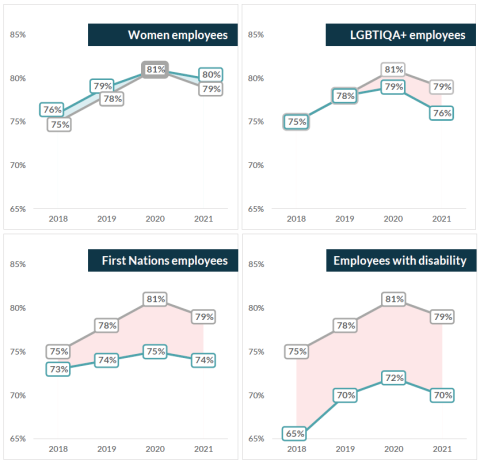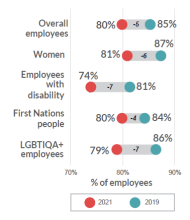Confident and capable leaders
“Inclusive leadership refers to the capabilities (i.e. mindset, knowledge, skills and behaviours) which ensure that a diversity of employee perspectives shape and improve an organisation’s strategy, work, systems, values and norms for success”.- Diversity Council Australia[i]
Inclusive leadership will be integral to achieving diversity and inclusion outcomes across the APS. Confident and capable leaders are required to drive the adoption of the inclusive practices and attitudes needed to support a diverse APS workforce.
A leader who is confident and capable in the diversity and inclusion space, will unconsciously lead by example. If employees feel safe in the workplace, they are more likely to show their ‘authentic self’, be happier and more productive.

|
Having easily accessible diversity and inclusion resources or training programs for current and future leaders to access will assist in building individual confidence and capability. |
Perceptions of inclusive leadership
Most APS employees agree that their agency supports and actively promotes an inclusive workforce culture (79% in 2021). The proportion of employees who agreed had been trending up since the question was introduced in the 2018 APS Employee census, but has slightly dipped in 2021. The potential for improvement is present in these results.
With the exception of women, employees who identify with diversity groups are generally less likely to agree their agency supports an inclusive workplace culture than employees overall are.
Percentage of employees that agree or strongly agree that their agency supports and actively promotes an inclusive workplace culture

Percentage of employees that agree or strongly agree that their immediate supervisor actively supports people from a diverse background.

Most employees (80%) also agree that their immediate supervisor actively supports people from diverse backgrounds. The proportion of employees who agree with this statement has also dropped between 2019 and 2021, trending consistently down across diversity groups and the APS as a whole.
The downward trend in employee perception of inclusive leadership may be related to the ongoing impacts of the COVID-19 pandemic. Leadership has changed significantly since 2020, with leaders having to manage remote teams, shifting priorities and new measures of success during the pandemic. Inclusive leadership is important during this transition to enable all employees to work at their best.
With remote and flexible working becoming more commonplace across the APS, there are higher expectations on leaders to be able to effectively manage diverse and flexible teams. These skills cannot be built in isolation from workplace policies, practices or position.

|
Employees with disability have been consistently less likely to agree that their agency supports and actively promotes and inclusive workforce culture or that their immediate supervisor actively supports people from diverse backgrounds. |

|
Conduct research to improve the understanding of the experiences of employees with disability. |
Diverse senior leadership
Improving representation of diversity groups at senior levels in the APS will help us to shape an APS workforce where diversity of thought, perspectives and skills are valued and employees feel a sense of belonging and engagement with their work. The representation of diversity groups in senior leadership has been slowly but steadily growing.
Women
In June 2021, women made up half of the SES cohort for the first time. The gap between the overall representation of women in the APS and their representation at the SES level has been steadily narrowing. Although women reached gender parity (50%) in the overall SES cohort in 2021, this has not been achieved at the SES 2 and SES 3 levels.

First Nations employees
The APS is not on track to achieve the target of 3% representation of First Nations employees at the SES levels by 2024. Although the representation of First Nations employees in senior leadership has grown in recent years, the rate of growth remains low. The APS needs to more than double the representation of First Nations SES employees in order to achieve the target of 3% representation at the SES levels by 2024.

Employees with Disability
Representation of employees with disability in the SES cohort lags behind overall representation in the APS, although the gap has approximately halved since 2018. The Australian Public Service Disability Employment Strategy 2020-25 sets an employment target for people with disability in the APS of 7% by 2025. Although this is a whole of APS target and there are not specific targets for SES levels, it’s notable that the APS would need to nearly double the proportion of employees with disability in senior leadership to reach this level of representation, as reflected in the APSED data.

Agency actions
In the 2021 Agency survey, agencies were asked what they had done to improve diversity in leadership roles. When asked what they had done in the last 12 months to improve diversity in leadership roles, agencies provided a wide range of answers[ii].
| External recruitment actions | Internal development actions |
|---|---|
| Affirmative measures | Diversity champions |
| RecruitAbility | Training leaders in diversity issues (CALD, cultural capability) |
| Diverse selection panel | Training those from diversity groups in leadership skills |
| Diversity statements with ads encouraging people from diverse backgrounds to apply |
|
| Train selection panel in unconscious bias/cultural capability |
"Advertised all leadership roles as flexible and/or part-time"
"Conversations with People Leaders in relation to improving diversity in leadership roles occurs as part of the annual workforce planning process and securing commitment for priority to a diverse and inclusive workforce."
"Providing training and development opportunities to build leadership capabilities in soft skills (including diversity recognition and inclusion, emotional intelligence and mentoring)."
Case Study – The role of a diversity champion Rebecca Lee, Industry, Science, Energy and Resources.
"Some of the ways I have been treated in the past have impacted me deeply and has meant I have hidden my disability for more than 10 years. As I have matured, I have realised the importance of being open and modelling life with a disability because if people can’t see it, how do they know what’s possible."
I was diagnosed with brain cancer at 30, the resulting surgery and treatment left me with what is called an acquired brain injury. This ‘invisible disability’, as they can be known, manifests itself through Aphasia, peripheral neuropathy, epilepsy, and Tourette’s syndrome. As you can imagine (and Google), this affects my speech and my ability to find the right word. I can get numbness, weakness, and pain with the nerves in my feet and hands. I also live with the possibility of a seizure every day, and I have tics through my hands, arms, neck, and head that I can hide, but it is exhausting and usually only a delaying tactic.
As Chief Information Officer at the Department of Industry, Science, Energy and Resources, I manage these as best I can to perform in my role and for my division of 400+ staff. I nominated to be a Disability and Inclusion Champion in the department as I wanted to set an example as a leader in the department for others to follow or be inspired by. It’s not enough to tell someone that they belong, we must create an environment where that person can thrive and achieve because of their unique life experience and perspective.
To create that supportive environment I have supported the following initiatives within my sphere of influence:
- the inaugural IT Accessibility Roadmap which has already seen a new focus on Accessibility across all our many initiatives
- prioritised Disability Awareness training for all IT employees
- developing and publishing guides on Digital Accessibility for all staff to utilise as they create content and documents
- facilitating a 10+10 forum for the Secretary and Executives to hear first-hand from employees with disability.
At the beginning of 2020, I shared my story as someone with a disability with the whole department (4000+ staff) at the launch of the department’s Inclusion Strategy – this is where the quote at the top is from. What I didn’t know at the time, but do now, is that by no longer hiding my disability I have a freedom that I didn’t think would be possible. I no longer have to use techniques to cover up my deficits and instead just openly say that I am struggling today. More importantly it has changed me as a leader. I am a better leader. I have more compassion and I am more empathetic. I seek diversity and inclusion everywhere I am. This supports us breaking the bias.
I know I am not alone in the silent struggle that so many are enduring with seen and unseen disabilities. The pandemic has highlighted and inflamed this struggle, and if I am not willing to share my story, how can I expect others to feel safe to do so. By sharing my own story, I hope to continue to foster a safer environment for staff to share their lived experiences, ask for the support that they need, and eventually thrive in an environment that is aware of their value. This all starts with a culture of support, openness, compassion and creating a society that makes this journey easier for the next generation to follow in our footsteps.
Case study – Building Mental Health Capability
In its inaugural year the APS Mental Health and Suicide Prevention Unit (the Unit) has achieved significant influence in relation to its prime aims of delivering whole-of-APS approaches to building workforce mental health and suicide prevention capability and promoting evidence-based mental health and wellbeing initiatives across the service.
The APS Mental Health Capability Framework
One of the Unit’s primary functions is to support APS agencies to align their practice with the APS Mental Health Capability Framework (the framework). The framework is a systems-based approach to building mental health capability, designed specifically for the APS operating context. It was endorsed by the Secretaries Board in August 2021. The framework provides APS agencies with the overarching architecture to build their mental health capability, while being flexible and adaptable to agency-specific needs. The framework is underpinned by six evidence-informed domains.
Domain 1: Prevent Harm
Domain 2: Promote Mental Health
Domain 3: Support Recovery Pathways
Domain 4: Build Literacy and Develop Capability
Domain 5: Leadership and Governance
Domain 6: Evaluate and Improve

The Unit is engaged with over 30 agencies in relation to the framework, with more than 20 agencies actively in the process of implementing the framework. These agencies represent a range of portfolios and vary in size from fewer than 100 staff to over 10,000 staff.
To support agencies, the Unit has developed a flexible six-phase implementation approach which includes supporting agencies to visually articulate their own mental health and wellbeing systems and to evaluate these against the best practice model for the APS, represented by the framework.
[i] Diversity Council Australia https://www.dca.org.au/di-planning/inclusive-leadership#:~:text=Inclusive%20leadership%20refers%20to%20the,values%20and%20norms%20for%20success.



